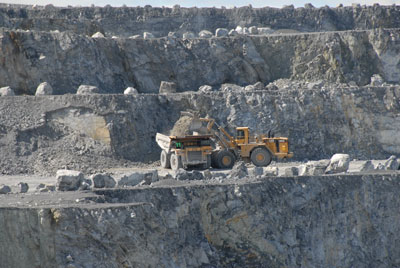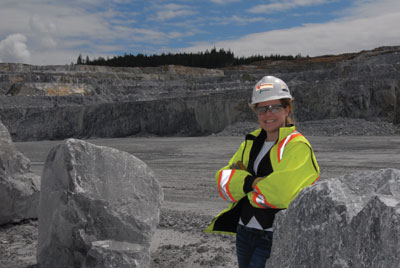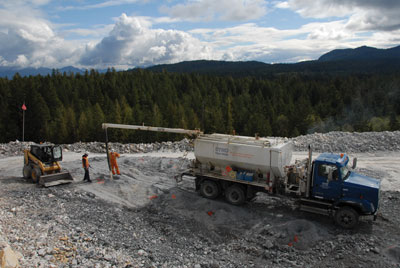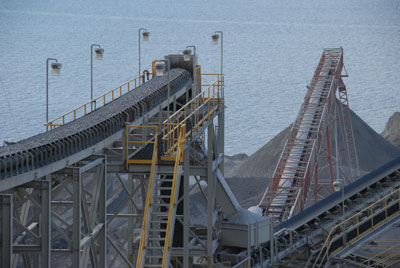
Features
Aggregates
Profiles
Having a BLAST
Keeping production flowing at one of Lafarge’s largest quarries means blasting rock almost every day
June 13, 2011 By Bill Tice
The decal on Sarah Bond’s well used hardhat says it all. “I LOVE
EXPLOSIVES,” it states in bold capital letters with a stylized red heart
replacing the word “Love.” Bond, who is just 26 years old, is the drill
and blast supervisor at Lafarge Canada Inc’s Texada Island operation in
southern British Columbia.
The decal on Sarah Bond’s well used hardhat says it all. “I LOVE EXPLOSIVES,” it states in bold capital letters with a stylized red heart replacing the word “Love.” Bond, who is just 26 years old, is the drill and blast supervisor at Lafarge Canada Inc’s Texada Island operation in southern British Columbia.
 |
|
| Mark Robert in the Caterpillar 992 loader loads up cement rock in the main pit for Caterpillar 777 haul truck operator Bruce McGee.
|
For Bond, this is her dream job. However, she is the first to admit it wasn’t planned and she didn’t know where she would end up when she started with Lafarge three years ago, and being in charge of blasting for an operation wasn’t even on the radar screen. “I signed on with Lafarge right out of school after taking a degree in Materials Engineering (B.Eng) at McMaster University in Hamilton, Ont.,” she explains. “When Lafarge hired me, they put me into the Lafarge Leadership Development Program (LLDP), which is a management training program that exposes you to all different areas of the company.”
Bond’s first stint with Lafarge was in Edmonton, Alta., where she was a labourer and handled some quality control and minor maintenance tasks at the Onoway Wash Plant. “That job involved a lot of shovelling,” she says with a chuckle. “But I also learned a lot as I handled screen changes, roller changes and other minor maintenance.”
From there, Bond was assigned to the company’s Land Department, where she worked on site surveys and mine plans and permits for the company’s operations in the Edmonton area. That experience exposed her to site reclamation plans and working with the provincial government’s environment department. Next for Bond was a move to the Vancouver area, where she also worked in the land department, before being transferred to the Texada Island operation. That is where she finished up her two-year training program last June.
“They originally sent me to Texada under LLDP to work as an assistant supervisor in the fixed maintenance department,” she notes. “Around the same time as I finished the program, the drill and blast supervisor position was posted, so I applied for it.”
She hasn’t looked back since, saying the “on the job” training has been just fantastic. “The previous drill and blast supervisor and other shift supervisors have provided me with lots of support since moving into my new position and I’m still learning every day with the drill and blast crew also being an absolutely critical part in this process,” she explains. “Some of these guys have been doing this for thirty-plus years. They know the rock, they know what they are doing, and they are eager to explain it to me.”
Detailed Planning
Most of Bond’s work around the blast sites involves the detailed planning required to complete successful and efficient detonations. She doesn’t handle the explosives or detonate the charges. That’s a job she explains is left to experienced professionals. First and foremost for her is site safety and protecting the environment, then minimizing cost. “The key to safe and successful blasts is planning,” she says. “If we use less explosive powder, our costs are lower, but we will have larger rock and that is hard on the crushers. If we use more powder, the rock is too small, and we end up with too many fines, which poses issues for our customers and their processes.”
 |
|
| Texada’s drill and blast supervisor Sarah Bond in the main pit.
|
With blasting happening at Texada almost every day, Bond is getting lots of chances to perfect the technique. Typically, she says they will do about 10 to 20 holes per blast, and some days they will do two blasts. When planning her blasts, she says one of the key factors is ensuring there is enough burden (rock in front of the blast holes). “If there’s not enough, you will blow rock all over the place and energy is wasted, if there is too much you end up with poor fracture,” she explains.
To keep it safe, she says they have strict protocols, including guards to ensure the area is kept clear, radio silence during blasting, and thorough post blast checks to make sure all holes were detonated. “You can’t leave explosives in the ground,” she says. “So when we are finished, we have to check to make sure everything detonated, and once we start the process of loading, we have to complete it.”
The blasts are all electronically controlled and ANFO is used as the primary ingredient. “It’s ammonium nitrate that is mixed with fuel oil as a conditioner,” says Bond. “If we are working in wet conditions, we use plastic blast hole liners. Otherwise we just go straight into the hole.”
Each hole has a charge, which Bond says is called a “booster.” This is connected with a detonator cord to time delays on the surface. “Typically, we have a 25-millisecond delay between each hole,” Bond adds. “That delay loosens things up for the next hole in the process.” The ANFO powder mixture is placed overtop of the booster, followed by a “collar” of 19-millimetre gravel to hold the explosives down and prevent fly rock.
To keep a close watch on the blasting process, Bond says they use a geophone, which is a disc set into the ground that converts ground movement (displacement) into voltage that can be used to measure the seismic response. In addition they use a microphone attached to the same control box which measures the volume of the air overpressure from the blast. Other technology Bond is using includes a global positioning system (GPS) coupled to software that helps her plan the exact locations, size and depth of her drilled blast holes.
Mine Rescue Team
In addition to her day-to-day tasks, Bond has embraced the job in a big way, getting involved in other aspects of the operation. She is particularly excited about her role with the mine rescue team. “If there’s an emergency in the pit, we are trained in rescue operations,” she says. “That includes fire fighting, first aid, climbing, rapelling, dealing with gas and working with breathing apparatus. We do have a volunteer fire department and one ambulance on Texada Island, but we have to be self-sufficient. We are the first responders if there is an issue.”
 |
|
| Len Street and Kevin Behan load the blast holes with ANFO in the white rock pit of Lafarge’s Texada Island quarry.
|
Normally, Bond says they spend eight hours every three months training for mine rescue, but she says right now they are training twice a month for eight hours per day. “We are entered in a surface mine rescue competition this summer in Revelstoke, B.C., and we want to do well,” she says as her competitive side shows through.
Bond is also involved in the Texada Island operation’s health and wellness program, in which she and her supervisor Denny Lyman, production shift manager, are leaders. It’s a Lafarge company-wide program where teams from each operation compete against each other in areas such as weight loss, exercise and
eliminating smoking.
When asked what is the best thing about her job, Bond doesn’t hesitate before answering. “Just look at the view,” she says while stretching out her arms to illustrate the vast ocean scenery from one of the highest benches in the quarry. “And, in our process, this is the first step,” she adds. “We are taking the rock out of the ground. It’s raw, it’s exciting, and it’s really cool to watch things blow up.”
Remember, Bond’s hardhat decal does say, “I LOVE EXPLOSIVES.”
Balancing Act
The drilling and blasting crew at Lafarge’s Texada Island operation are
just the beginning. The company has also invested in equipment and
programs that are helping the quarry to create a positive return on
investment, while supporting the local community and protecting the
environment.
 |
|
| The “long belt” at the Texada operation feeds cement and chemical rock to the barge loading area.
|
Lafarge’s Texada quarry is one of the company’s largest North American aggregates operations. Last year, they shipped out over 3.25 million tonnes of product and they have handled as much as 8 million tonnes annually when market conditions were at their peak. In terms of the future, the company estimates the Texada operation has enough reserves to last for at least 100 years at current extraction rates.
Shawn Holloway, Texada’s general manager, attributes a big part of the operation’s success to being diversified, as he explains they not only produce various limestone and hard rock products, but also have a transshipping facility that handles products for other companies who lack their own deep sea infrastructure.
“Prior to the recession, Lafarge had made a significant investment in fixed equipment, including a ship loader (at Texada), which we are now looking to make a return on,” Holloway explains.
Most of the products produced at the Texada quarry are for the local southwest B.C. market, including Vancouver, and are shipped out by barge. The ship loader, which was designed to handle between 2,500 and 4,000 tonnes per hour, depending on product, handles an assortment of materials for customers, ranging from hard rock aggregates to coal.
Production
The Texada operation’s main product line includes a cement grade limestone, which is used by Lafarge’s Richmond, B.C., cement plant and other local producers, and a chemical grade limestone that is used for a variety of applications, including a filler in the paper manufacturing process. They also produce different hard rock materials, including a white rock that can be used as a brightening agent in consumer products and granite, which is used for both asphalt and construction grade materials.
Production at Texada starts with drilling and blasting. A pair of drills from Ingersoll Rand (now Atlas Copco) handles the drilling, including a DML model with an 8-inch bit and a DM45 equipped with a 6.75-inch bit. Once the blast holes are drilled and the blast occurs, Caterpillar equipment moves the rock to the limestone plant or the aggregates plant. The pit’s Cat gear includes one 992, two 990 and three 988G loaders. For rock trucks, they run three Cat 777 – 100 tonne models and six Cat 775 – 65 tonne models.
For the limestone plant, the trucks deliver the rock to a primary Jeffrey impact crusher, which is in a closed circuit with a 7-ft Cedarapids cone crusher, with material eventually conveyed down to the barge loading area.
At the aggregates plant, a Primary jaw crusher is first in line, which is followed by a secondary circuit, including a pair of Cedarapids MVP450 cone crushers. The final product is then conveyed and trucked to the shiploader.
Jobs and Community
Right now, the Texada operation runs on two eight-hour shifts, five days per week, but can run on weekends if necessary. They employ about 90 people, including hourly, salary and support staff.
For Texada Island and the larger Powell River community, which is a 35-minute ferry ride from Texada, the operation plays a big part in the local economy. The majority of the quarry employees live on Texada Island and Holloway estimates the operation contributes over $6 million annually into the two local economies, just in terms of salaries and taxes. The operation also plays a big part in the community by supporting the efforts of the United Way and by contributing to educational programs and funding post-secondary scholarships for
local students, especially those from Texada Island.
Environment
Protecting the environment is also an important aspect of the day-to-day running of the operation and in 2008, the Texada quarry and the company’s Van Anda Quarry, which is a smaller quarry also on Texada Island, were recognized for their biodiversity efforts when they were the company’s first aggregate operations in western Canada to be awarded Wildlife Habitat Council (WHC) Wildlife at Work certification.
Employees at the Texada operation have been actively planting native trees, providing habitat for raptors, and establishing pollinator gardens. They held a very successful bird-box building event involving the local community. They have also performed a survey of the marine foreshore around the quarry to better understand the species composition and how any future planning might affect the underwater ecosystem.
Cataloguing species of terrestrial and marine plant and animal species on the quarry property is a major aspect of the Wildlife at Work certification, as it allows employees to know what species are present and how mining activities might impact them.
As a result of the Wildlife at Work certification, a Wildlife Management Plan was created to set benchmark goals along specified timelines with regard to species on the quarry. These goals and their outcomes will change over time in response to changing conditions on the quarry but will always aim to protect the biodiversity of the area.
“We are really proud of the recognition our Texada operations have received from the Wildlife Habitat Council,” says Ron Bruhaug, the Vancouver-based VP/GM of aggregates and Greater Vancouver Area (GVA) markets for Lafarge. “Our employees have really embraced this industry leading program.” n
Print this page